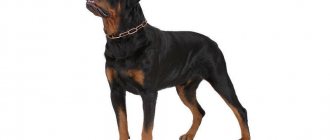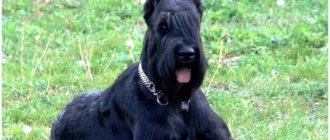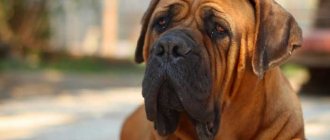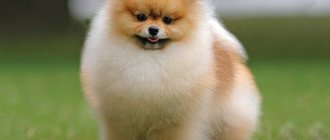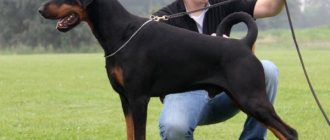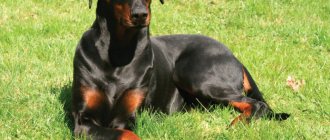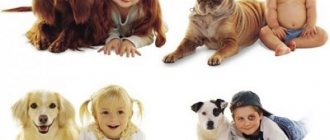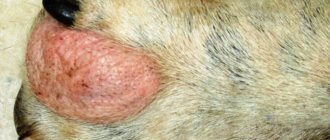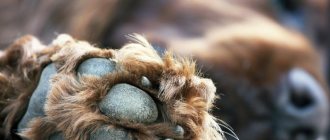As they said in one famous animated film: “Whiskers, paws, tail - these are my documents!”
But these “documents” are not required for all pets. As a result of canine selection and the centuries-long history of relationships between dogs and people, breeds were developed that practically do not have a tail. Dog breeds without tails or with short tails have been used for a variety of purposes, from soulful companions to rugged guard dogs. But do not confuse docked tails with naturally short ones. The former were dictated by the working qualities of the dogs, but short tails are the result of gene mutations fixed in the breed through selection. Moreover, this mutation is so strong that it is transmitted not only as short-tailedness, but also affects the length of the limbs, the development of the dorsal spine and the overall survival of embryos.
Why are some dogs born without a tail?
Some pet owners like tailless pets. Such preferences have led breeders to adapt to genetic mutations. In the context of the topic raised, it is necessary to touch upon the term tail docking, as well as understand how this process occurs.
Removing part or all of the tail is a long-standing practice used by dog breeders. When the procedure is performed after the animal is born, it is called tail docking, and the dogs undergoing it are classified as docked breeds.
The process is carried out surgically using scissors and is performed when the puppies reach the age of six months or more. Mostly, docking is amputation.
Docked dogs should not be confused with bobtails; in the latter, taillessness is natural.
Below are the breeds whose representatives are born without a tail.
How does the operation take place?
Cupping is carried out in a clinical setting by an experienced veterinarian. The length of the remaining tail must correspond to the standard of each specific breed. This can be 1-2 vertebrae or 1/3 of the tail.
Ears are cropped in a hospital setting using anesthesia. For each breed there are special patterns that determine the shape of the ears. After the operation, the puppy is given a special collar that prevents him from scratching his ears. It is necessary to carefully monitor the condition of the seams. Ears can be placed, if necessary, on the second day after docking. Surgery at a later age threatens the formation of scars. Before removing the stitches, the sutured ear must be massaged well to avoid “wrinkling” of the cut.
Boston Terrier
The Boston Terrier is the result of crossing an English Bulldog and a White English Terrier. This breed belongs to the bobtail breed. This means that its representatives are born tailless.
A large number of Boston Terriers are born with a small tail, which is accepted as a standard characteristic. If a dog has a long or docked tail, the owner may have difficulty registering the breed or recognizing the pet as a purebred.
The Boston Terrier is often called the American Gentleman. Its main features (besides its small size) include sociability, friendliness, developed intelligence and the desire to please the owner. These dogs are easy to train and try to protect their family members.
However, if not properly trained, the Boston Terrier can become aggressive. Violation of its territorial boundaries can also cause a negative reaction from a dog.
This breed is a loyal watchdog, an excellent companion, and only barks when necessary.
These dogs are known for their characteristic white and black coloring, as well as large, wide-set eyes. They are suitable for dog sports that require obedience, agility and diving.
Peruvian Inca Orchid
Rare breed in Europe, but common in Peru . The animals are believed to be non-native, having been brought from Africa or China. Images of similar dogs were found on the rock slabs of the ancient Incas. Peruvians treat dogs as deities. They are kept not only as a pet, but also to protect the house from evil spirits.
The dog got its name because of the funny crest on its head and the ability to change skin color depending on the seasons: in winter - light, beige, white; in summer – pinkish.
These are muscular, medium-sized animals with elastic skin. There are 3 growth varieties:
- mini (8 kg);
- standard (12 kg);
- maxi (25 kg).
Representatives of the breed are accustomed to hot climates and a nocturnal lifestyle, so the owners should not be disturbed?
Brazilian Terrier
Representatives of this breed are interesting because their tail can be long or may be completely absent. However, a docked tail is considered the standard.
In Brazil, this part of the body is usually docked, but if the dog is not subjected to the procedure, the tail grows short and thick. In some countries, surgery using a scalpel and scissors without anesthesia is prohibited.
The Brazilian Terrier has a narrow chest, folded ears and a triangular shaped skull. He inherited his tricolor color from his closest relatives - the Jack Russell Terrier and the Fox Terrier.
Representatives of the breed are smart and attentive animals. They love to play and dig holes. Due to their excessive activity, Brazilian Terriers require space (small spaces are not suitable for them), as well as constant training. If you don't provide your pets with outlets for energy, they will find entertainment that may not be to the liking of the household.
Features of maintenance and care
Bottom-tailed heelers are unpretentious. They are not afraid of heat or cold and feel good even in the Siberian climate.
Combing
Australian Shorttails are brushed regularly during the shedding season. To do this, use brushes with natural bristles or rubber gloves. Periodically they clean their ears and teeth, and wipe their eyes. Nail trimming is required if the animal does not grind them down on its own during walks.
Bathing
The fur of bobtail dogs has virtually no odor. It does not get dirty due to its rigid structure. They do not need frequent bathing.
Walk
Active games and long walks are mandatory conditions for keeping the Australian Shorttail. She needs to constantly splash out her seething energy. It is good if the pet lives in the yard, where nothing restricts its movement. Otherwise, he is taken out for runs every day and occupied with other active entertainment.
When kept in a confined space for a long time, bobtail heelers become aggressive, hyperactive and nervous.
Feeding
The main product in the diet (about 50%) of the Australian Shorttail is lean meat, as well as by-products: heart, kidneys, and gizzards. Additionally, they cook porridges - rice, buckwheat, oatmeal, and provide sea fish a couple of times a week. The menu is also enriched with:
- fermented milk products;
- vegetables;
- greens.
The diet of bob-tailed heelers should include vitamin and mineral supplements. Fresh water should always be freely available.
The Australian Shorttail will continue to work actively even if it is hungry. Therefore, food should be given to her on time, without expecting that she will ask for it herself.
English bulldog
These dogs are not always born tailless, so an English Bulldog owner should not be surprised if he is asked if he has docked his pet's tail.
In some representatives of the breed, this part of the body is so short that they are often perceived as tailless. In fact, all individuals have a tail, only their size differs - from very small to medium length.
The tails of some English bulldogs are docked, but in a number of countries (USA, UK) this is considered illegal. Sometimes this part of the body can be cropped for medical reasons.
In most cases, dogs are born with a short, straight or curled tail. The first option is preferable and is recognized as the breed standard.
By nature, English Bulldogs are quite stubborn, but over time they become patient and friendly. They are family oriented and are known to have a strong attachment to their owner. Representatives of the breed are not energetic, but they adapt well to any environment and also get along with children and pets.
Among English bulldogs there are long-tailed individuals, but this is considered a deviation from the norm.
Pros and cons of black dogs
If we consider the advantages of a dog with black coat color, the following facts are noted.
- noble, eye-catching exterior of the pet. They look mystical, special;
- They look advantageous, especially in the city, compared to other representatives of the Volchi. If a dog with a light color gets dirty in the mud or gets into a puddle, then this will immediately catch your eye. In dark breeds it is not so noticeable;
- There is less noticeable lost hair left on furniture and floors in the house;
- Shedding in smooth-haired and wire-haired dogs is less noticeable than in other dogs of different breeds.
Among the shortcomings, dog handlers draw the attention of owners to the following phenomena:
- Regardless of the length of the coat, black-colored animals tolerate heat and sun less well;
- dark dogs are popular and due to the “fashion” for breeds, genetic deformations are possible due to crossbreeding;
- many pets require careful care due to the structure of their hair and special grooming;
- When choosing a puppy, examine the pigmentation of the skin, nose, ears and irises of the eyes.
Sometimes a small white spot is allowed. An indicator of “purity” for selective selection is the pronounced color of the lips, eyelids and often the mouth.
Nowadays the market offers special cosmetics that help make hair strong, strong, and give it a beautiful shine. Last but not least is proper feeding, which helps to enhance the nutrition of the hair follicle.
Vitamins and minerals are necessary for animals just as they are for humans. Breeds that are prone to skin diseases and allergies require careful attention. Subcutaneous rashes on black fur are not as noticeable as compared to white ones. The deterioration of the pet's general condition is reflected in its behavior.
French Bulldog
The descendant of the English Bulldog was bred with a short and thick tail, which often raises questions among others regarding the connection.
Representatives of the breed are born with three types of tails - straight and short, curled (screwed) and short, as well as with a thick base and a thin tip. Regardless of the type, these nearly missing body parts can cause health problems for your dog. Over time, French Bulldogs' tails have developed incorrectly, resulting in a poor connection to the spinal column. For this reason, the animal may experience spinal deformities throughout its life.
These changes are not only painful, but can also cause nerve damage. They are determined by genetics and are an attempt by breeders to achieve the breed standard of a curled tail.
French Bulldogs are small dogs that make excellent companions. They are smart and calm, show good watchdog abilities, and also strive to protect their family members. These pets are patient and eager to have fun, so it's no wonder they are often called "clown dogs."
Education and training
Despite their non-aggressive nature, Australian Cattle Dogs require education and training. They are very smart pets, from puppyhood they learn to quickly understand what is wanted from them: they respond to a nickname, get accustomed to their bed, to the tray, and later (after the required vaccinations) to walks, they do not beg or spoil things, they forget about dominant behavior .
The age from 8 to 11 weeks is considered the most important for the formation of a dog’s psyche: serious stress and fear are unacceptable. From about 4 months, start training your baby: teach the commands “Come to me!”, “Fu!”, “Near!”, necessary for safety on the streets.
Active socialization of the heeler from about 3 months of age will prevent his possible aggressiveness towards other animals, birds and strangers.
Croatian Shepherd
In past times, the Croatian Shepherd was born with a long and curly tail, which was docked after birth. However, with the introduction of an official ban on this operation in the country, breeders have only one option left to have a tailless representative of the breed - through selection.
Nowadays, most puppies are born with a very small, moderately high tail covered with thick hair, or no tail at all. In some countries, this part of the body can be docked by 2.5 cm. Cupping, for example, is recognized as a legal procedure in the USA.
When at rest, the Croatian Shepherd's tail is lowered, and when alert, it is raised above the back.
The Croatian Shepherd belongs to the group of herding dogs. She was bred and used for the purpose of looking after sheep and cattle in Slavonia (historical region of Croatia). The appearance of the breed dates back to 1374.
These dogs are medium in size with a rectangular body, and their head and paws are covered with short hair.
Cropping ears
In this case, a lot depends on the breed. For the Caucasian Shepherd, this is the third day of life. The operation is not too complicated. For puppies, the top of the ear is simply cut off while it is very thin. You get ears like those of a bear. Therefore, it is quite possible to crop a puppy’s ears and tail at the same time.
If we are talking about Dobermans or Great Danes, then everything is more complicated. The owner needs to wait until the babies are three months old. During this time, the head and ear will reach the desired size. Before the procedure, the babies are not fed for eight hours, after which they are taken to the veterinary clinic. There, surgeons are already taking up their work:
- First of all, anesthesia is administered. The puppy is placed on a special table, its paws are extended and firmly secured. In addition, the puppy’s jaw and torso are fixed.
- The auricle is treated with an antiseptic, and the area where docking will be done is cleaned of hair.
- Using a special pattern, doctors cut the desired shape. The operation lasts about an hour, so the owner needs to be patient.
- After the operation, the treatment is repeated and the patient is sent home. The stitches usually need to be removed after two weeks.
Breton epañol (Breton)
Bretons are compact dogs that are in most cases born tailless. However, sometimes puppies with long tails appear in the litter. As for docking this part of the body, the procedure is used quite often in relation to representatives of the breed. Docking is carried out at a distance of approximately 10 cm from the base.
For a dog, the tail is important, performing functions such as maintaining body balance and communicating with other animals; When swimming, the tail acts as a kind of rudder, helping to follow the chosen direction.
The Breton Epagnole is medium in size and has a pleasant appearance. It is characterized by agility, strength, energy and the ability to move quickly. Among its qualities are severity and hyperactivity, which is associated with the origin of the dog - it was previously used during bird hunting.
Bretons are great for family life, but they need activity and plenty of daily exercise.
Long-haired dog breeds
Afghan Hound
The Afghan Hound has much in common with the Saluki; the breed originated in Afghanistan and was used for guarding and service. The average weight of a pet is 35 kg. The breed is distinguished by its long coat of cream, beige with black markings. By nature, they are patient, obedient, devoted and savvy animals who love children.
Read: Super premium food.
Bobtail
The bobtail first appeared in England, the name translates as “Old English Sheepdog.” Previously, the breed was used for grazing livestock, now as a companion. The size of the bobtail is large, the coat is long, thick with curls. The main shade is gray with blue, marble, blue with black. The character is characterized by kindness, sociability and attentiveness. The peculiarity of the animal is its loud bark.
Yorkshire Terrier
The Yorkshire Terrier dog is a small, decorative dog that originated in England and is considered one of the most popular pets in the world. The animal's coat is long, silky, and becomes lighter with age. The main color is golden, bronze, cream, often several shades at once. The terrier is distinguished by fearlessness, courage, activity, and playfulness.
Collie
Collie (Scottish Sheepdog) is a medium breed of dog, bred for herding livestock in England and Scotland. Now the pet is used for canine competitions or as a companion. Average size - 25 kg, has muscular paws. The coat is long, sometimes rough. The main colors are black, red, tan, sable. The animal's temperament includes endurance, intelligence, activity, and sociability.
English cocker spaniel
The Cocker Spaniel was bred in England for hunting and later became a friend and companion for many owners. The dog has a medium build, weighing up to 15 kg. The coat is long, silky, the main color is red, black, tan and black with blue. The dog's character is characterized by mobility, energy, peacefulness, and attentiveness to the owner's mood.
It is important that your cocker spaniel gets plenty of walks, active play, and training. It is better to keep it in a country house to satisfy the hunting instinct.
Maltese (Maltese)
The Maltese is a small breed that first appeared in Malta. The main feature is long, thick wool of a snow-white shade. Average weight – 3 kg. The main highlight of the breed is its tenderness and sensitivity, intelligence. The dog is also characterized by mobility, savvy, courage, and loyalty to the owner. As a child, the Maltese bites and snaps, so it requires training.
Newfoundland
The Newfoundland dog was bred in Canada for work and hunting. The main feature of the breed is its long, thick coat of black, black-white or brown shade. Belongs to the Molosser breed, the maximum weight of the pet is 67 kg. By temperament, they are calm, balanced, intelligent and flexible animals. It is better to keep it in a country house, as it requires a lot of space for walking, is easy to train and makes decisions on its own.
Pomeranian Spitz
The Pomeranian Spitz is a decorative breed that originated in Germany, the province of Pomerania. The main feature of the dog is its long, soft and fluffy fur, as well as a small fox-like muzzle. Wool comes in ten shades, but the most popular are black, black and tan, cream, red, and blue and tan. Despite its small size, the dog is fearless, playful, active, and loves children.
Remember that the Pomeranian Spitz is characterized by aggressiveness and jealousy, so the pet needs to be given a lot of time, raised and trained.
Pekingese
The Chinese Pekingese is a small breed of apartment dog that originated several thousand years ago in China. It is interesting that the Chinese themselves call dogs “fu” and consider them protective spirits. The coat comes in several shades, but black and red Pekingese are more common. The weight of the animal does not exceed 5 kg. By nature, they are playful, spoiled, independent pets.
Saint Bernard
The long-haired Saint Bernard originated in Switzerland and Italy and is believed to be a descendant of Tibetan mastiffs, which were used to climb the Alps. The dog has a large body, thick coat of white or red color with spots. The main feature of the St. Bernard's character is loyalty and obedience; they are also characterized by attentiveness and love for family.
Tibetan mastiff
The Tibetan Mastiff is considered one of the oldest breeds that originated in Tibet and previously lived in monasteries. Externally, it is a large pet, weighing up to 75 kg. The mastiff's coat is thick, with an undercoat of gray, dark, beige shades with spots. Despite its size, the pet is distinguished by calmness, obedience, loyalty, and adequacy. They can be guards, defenders, and used for hunting.
Chow chow
The name “Chow Chow” is translated as shaggy lion, which fully corresponds to the appearance of the dog. They first appeared in Korea; the breed belongs to the Spitz group. Can be used for home security or as a companion. The coat of the Chow Chow is long, fluffy and thick, the main color is black, blue, red, cream. The average weight of the animal is 27 kg. By temperament, the dog is characterized by caution towards strangers, love and loyalty to the owner, and laziness.
It is important to go for walks with your chow chow as often as possible and do some training. Because the pet prefers to lie on the sofa than to run and play, which is why it often suffers from obesity or a bad mood.
Shih Tzu
The Shih Tzu is considered one of the most ancient breeds; it first appeared in China as a gift to the emperor. A small Shih Tzu dog with long hair of different shades, but the most common colors are black, red, brown and white-red. The maximum weight of a pet is no more than 8 kg. By nature, they are active animals, require a lot of attention, are attentive to the mood of others, love children and are devoted until the end of their lives.
South Russian Shepherd
The South Russian Shepherd Dog was bred in Russia to herd cattle several hundred years ago. In size - a large dog with long hair of white, fawn, gray-piebald shades, average weight - 25 kg. A shepherd dog can be used for protection, security, service and as a pet. The shepherd's character is characterized by savvy, independence, loyalty, and anger towards strangers. Therefore, you need to start raising a dog from childhood.
Bourbon braque
You may find similarities between Bourbon Braque and Breton Epagnole. This is explained by an identical mutation that affects the formation of the tail of animals. Brackets are also often called short-tailed pointers.
These animals are born with a short tail or no tail at all. This feature is due to the fact that breeders, in the process of forming the breed, adhered to strict requirements for color and tail length. The result was a dog whose characteristics were more important in appearance than in abilities. This led to a loss of interest in the breed for some time: no puppies were registered between the mid-1960s and mid-1970s.
The breed's revival occurred after standards were relaxed, tail docking was allowed, and attention was paid to developing the dog's hunting instincts.
Despite the fact that the birthplace of the Bourbon Braque is France, the dog is currently being actively bred in the United States. The main distinguishing features of this small pet are its developed hunting abilities, activity and the ability to quickly change direction while moving.
There are two types of Bourbon Braque colors: liver (wine, faded lilac) and tan (peach). Representatives of the breed have a slightly rustic appearance. Females are generally much longer, thinner and more elegant than males.
Recovery after surgery
Even if we are talking about tail docking, it is still a surgical intervention. Therefore, the doctor must assess the risks and familiarize the breeder with them. If the puppy is weak, then it is recommended to postpone this procedure and, at an older age, perform it under anesthesia or abandon it altogether.
After tail or ear docking, puppies require the most careful care. The place where they sleep should be dry and clean so that there is no risk of infection. The wound must be examined twice a day. The slightest signs of suppuration are the reason for an immediate visit to the doctor. Such intervention in itself is traumatic for the animal. Therefore, a decrease in appetite may occur and drowsiness may occur during the first two days after the procedure. But if the puppy completely refuses to eat, then you need to sound the alarm.
Australian short-tailed cattle dog
Heeler (the second name of the breed) is of medium size. It is a naturally tailless working dog and differs from the Australian Cattle Dog, which has a docked tail. However, both of these breeds are bred in Australia for herding.
Heelers are energetic animals that are characterized by attentiveness and obedience. They are loyal to their owners and reserved with strangers. Representatives of the breed are able to withstand harsh weather conditions, which is necessary for a herding dog.
The natural taillessness of heelers (or the presence of a short tail) is the result of the work of breeders. The current standard requires that this body part be no longer than 10.2 cm.
Due to the fact that Australian short-tailed cattle dogs are bred only in Australia and Canada, they are considered quite rare.
Appearance of the Australian Heeler breed
The breed standard states that the Australian Heeler should be compact and proportionate. This is a medium sized dog. The height of males at the withers is not lower than 44 cm and not higher than 51 cm, weight from 15 to 23 kg. Bitches are slightly smaller and lighter, height 42-50 cm, weight at least 15 kg.
The Australian Kettle's appearance combines strength and endurance. This muscular dog is harmoniously built, but should not be rough.
The Kettle's head is proportional and quite wide. The transition between the forehead and muzzle is well defined. The nose is wide at the base, becomes narrower towards the lobe, its color is only black.
The Australian Heeler has strong jaws with healthy teeth. For a herding dog this is of particular importance.
The eyes should be medium in size, with dark brown irises, and intelligent. The dog looks calm and confident. When strangers or some other danger appears, his gaze becomes more attentive and wary. The dog seems to warn someone who encroaches on its territory or pack.
The Australian Heeler's ears are not very large and erect. They are spaced wide apart and directed slightly to the side. If something worries the dog, it turns its ears straight forward.
The shepherd dog has a muscular neck that extends into a powerful chest and strong body. She has a straight back and a lean stomach. The limbs are well developed, strong, but not overloaded with muscles.
The tail is set quite low, and when relaxed it falls almost to the joints. A fluffier “brush” is clearly visible at the end. An excited dog raises its tail, but it should not be higher than its back.
The Australian Heeler breed has a smooth, rough coat that repels water. The length of hair on the body is on average 2.5 - 4 cm. The undercoat is approximately half as long, thick and dense. Slight feathering on the hind legs is normal. Excessive fluffiness, as well as too short fur, are vices.
The color of the Australian Kettle can be blue or blue, blue-speckled, as well as red and red-speckled. Symmetrical markings of black, bluish or yellowish-red are allowed on the muzzle; sometimes there is a “mask”. Black spots on the body are undesirable. Possible, but not obligatory, tan on the limbs, chest and throat with transition to the jaws and cheekbones, on the back of the inner thighs and paws.
The Australian heeler moves easily and naturally, and is particularly swift. As they say: he rushes right off the bat. He can run a long distance and hardly get tired at all. And then quickly regain strength.
Serious breed defects include:
- Weak front and hind limbs
- Straight shoulder blades and straight knees
- Wrong position: cow or goat
- Yellow or blue eye color
- Unnatural, related movements
Dogs with obvious deviations in appearance and physical condition, as well as with significant behavioral problems, are disqualified. The vice for the Australian Heeler breed is both excessive timidity and excessive aggression.
Pembroke Welsh Corgi
There are two types of Welsh Corgis: Cardigan and Pembroke. The main difference between them is the tail. If the first one has a long one, then the second one is born tailless, or this part of the body is very short.
Since short tails are currently in demand, tail docking is very popular. According to current standards, it should be performed as close to the spine as possible, but without creating a depression.
The Pembroke docking procedure was carried out everywhere for a long period of time, until in some countries it was banned at the legislative level. Some representatives of the breed were bred only because breeders sought to obtain short-tailed dogs.
A small ponytail is the result of a recessive mutation of the T gene. Thanks to this feature of the body structure, the Pembroke can be distinguished from the Cardigan Welsh Corgi.
This breed belongs to the hunting group. Its representatives are active, but at the same time gentle and affectionate animals.
To dock the tail or not
Whether or not to dock a corgi's tail is up to each breeder to decide for himself. This procedure can be carried out in the first 3 days of the puppy’s life, so you need to quickly decide whether to dock your pet or not.
You can focus on your preferences or on what exhibitions Pembroke will participate in in the future. In some countries around the world, docked participants are not allowed to participate in exhibitions, even if they live in a state where this procedure is permitted.
If you are purchasing a pet for a family, you should look at photographs of puppies and adult corgis and make a choice in favor of the one you like best. Pembrokes look great with or without a long tail.
Experts on the ban on docking
Just a few years ago, Pembroke Welsh Corgi dogs with tails could not look natural. Today the situation has changed, and such individuals can even participate in competitions and exhibitions. However, many experts say it is impossible to accurately predict what an adult dog's tail will look like.
Since the docking procedure is carried out in the first days of a puppy’s life, the shape of the tail may change as the pet ages. The tail can be thrown up or curled into a ring.
Experts urge not to despair if the shape of the Pembroke’s tail suddenly changes, since at domestic competitions judges have not yet focused on the irregular shape of the tail. In any case, you can resort to surgical intervention, as a result of which the irregularly shaped process is corrected.
It doesn’t matter whether the corgi has a docked tail, a short one or a long one - the main thing is that the pet is loved, lives in a warm, friendly atmosphere, and enough attention is paid to the care and education of the corgi. After all, if a pet is happy, its owner will be happy too.
Australian Shepherd
This medium-sized dog is born tailless or with a shortened tail, but the vast majority of individuals have a long tail. This circumstance causes a misunderstanding of what the tail of a purebred animal should actually be like. There is controversy among breeders regarding the correct and healthy body of an Australian Shepherd, because... both options (with and without a tail) are formed naturally.
Currently, taillessness among representatives of the breed is considered to be the norm, because One out of five individuals is born without this part of the body. Many animal owners, in order to maintain the dog’s familiar appearance in their country, carry out a docking procedure.
Typically, a dog's tail tapers towards the tip, which is associated with a gradual decrease in the size of the vertebrae. However, in the Australian Shepherd, the vertebrae at the end of the tail are often missing, creating a stubby appearance.
Representatives of this breed are smart, very energetic and need daily training.
Doberman
This is a relatively young breed of dog without a tail. Photos of these beauties, unfortunately, do not convey all their grace and nobility. The breed was formed in Germany in the 19th century thanks to the dedicated work of Friedrich Louis Dobermann. According to some assumptions, butcher dogs, Old German Pinschers, Setters, Greyhounds, Pointers, English Mastiffs and Blue Danes were used to breed it.
The Doberman is a tall, athletic dog with well-developed muscles. Depending on the gender, its height is 61-71 cm with a weight of 30 to 40 kg. The entire body of this animal is covered with short, stiff hair of blue, brown, black or isabella color with symmetrical tan markings.
The Doberman is endowed with an active, lively temperament. He is characterized by such traits as fearlessness, vigilance and intelligence. He is easy to train and needs regular exercise. If necessary, this brave and determined dog will become not only a loyal friend and cheerful companion, but also a reliable protector.
As they said in one famous animated film: “Whiskers, paws, tail - these are my documents!” But these “documents” are not required for all pets. As a result of canine selection and the centuries-long history of relationships between dogs and people, breeds were developed that practically do not have a tail. Dog breeds without tails or with short tails have been used for a variety of purposes, from soulful companions to rugged guard dogs.
But do not confuse docked tails with naturally short ones. The former were dictated by the working qualities of the dogs, but short tails are the result of gene mutations fixed in the breed through selection. Moreover, this mutation is so strong that it is transmitted not only as short-tailedness, but also affects the length of the limbs, the development of the dorsal spine and the overall survival of embryos.
King Charles Spaniel
These small pets are often called English Toy Spaniels. They enjoy spending time in the company of family members and can be kept as lap dogs.
Sometimes King Charles Spaniels are born with a full tail, but if a break is found on this part of the body, breeders prefer to do the docking, leaving two-thirds according to breed standards.
If the animal has a long tail, it should be at the level of the back and be in motion while working.
King Charles Spaniels are descendants of hunting dogs, although they are not used for this purpose. They are friendly, intelligent, and even-tempered, making them excellent therapy animals.
Representatives of the breed do not have much energy, but they know how to get along with children and feel good in the family circle. Breeders recommend avoiding rough handling when interacting with this pet.
King Charles Spaniels have dark eyes and a short muzzle. They are good guards who will raise their voices when strangers try to enter their territory.
Interesting Facts
The Kettle Dog is not a dog with a long history. But over the entire period of the breed’s existence, many interesting things have been associated with it:
- The Australian Kettle Great Dane is born white with dark spots. It does not acquire its color immediately, but after a few weeks.
- 14% of Kettle Dogs are deaf in one ear, and 2% of dogs of this breed are completely deaf.
- The Australian Kettle Great Dane is a long-living dog. The maximum documented age of a dog of this breed was 29 years.
- In some countries, Australian Cattle Dogs are used as psychologists. Strong positive energy allows them to take part in canistherapy, which is carried out in nursing homes and boarding schools for children with developmental delays.
- The first Australian Kettle Great Dane came to Russia in 2004. A female of this breed named D'astra Canina Diamantina was imported to Moscow from Poland.
- The Australian kettle made its mark in American cinema. A dog of this breed starred in the second part of the film “Mad Max”.
Miniature Schnauzer (Miniature Schnauzer)
These dogs are not only friendly and caring, they are very attentive and have watchdog abilities. Most Miniature Schnauzers are born with a tail, but some are naturally tailless.
The natural absence of an important part of the body is caused by a mutation, which, in turn, can be fatal, because. causes deformities in puppies. However, not all tailless miniature schnauzers are carriers of an undesirable gene responsible for such serious consequences.
These dogs are smart and obedient. They tend to want to please their master, so they are easy to train. Miniature Schnauzers are active and require regular exercise, but they can live both in an apartment and in a country house.
Most representatives of the breed are born without a tail. The docked animals belong to the American Kennel Club.
Health, maintenance and care
The breed is generally in good health, but there have been cases of hereditary deafness, spinal problems, and eye diseases, particularly pannus (superficial keratitis), an epithelial growth on top of the cornea that produces a grayish haze that can impair the dog's vision.
Taming bob-tailed Australian heeler puppies should begin at an early age, although despite all the efforts of the owners, some individuals remain poorly socialized, which is why Stumpy breeders rarely give puppies to hobbyists. These dogs need exercise, work and space, so when deprived of all this they exhibit destructive behavior. In addition, they, like dingoes, do not bark, but howl at night, which excludes the possibility of keeping them in urban conditions. Caring for the coat, which has an “all-weather” structure, boils down to combing and washing as needed.
English Shepherd
The origin of the English Shepherd is covered in legends, according to which the blood of the dogs of the British Isles and the shepherd dog flows in its veins. These animals were brought to Europe by statesman Julius Caesar during his invasion in 55 BC, and then followed with the first settlers to America.
Generally, the English Shepherd's tail is of medium length, with the tip reaching the knuckle. When the dog is resting, it is held straight and up or behind the back.
Among the representatives of the breed there are also bobtails, which are recognized by the American Kennel Club; their tail length is in the range of 15.3-18.3 cm.
English Shepherds are medium-sized animals with good balance. They are energetic, smart and courageous. Such a dog quickly responds to the owner’s commands and becomes an excellent companion for him.
History of the origin of the Yorkshire Terrier breed
The history of the origin of Yorkshire Terriers began in England and received its name in honor of the city of York, located in Yorkshire. At the end of the 19th century, Yorkshire Terriers were used primarily for catching rats in mines and as burrowing hunting dogs. Initially, they were very common among representatives of the working class, and later these beautiful long-haired dogs won the hearts of ladies of the upper classes of European society, becoming their companions and real favorites. The official history of the Yorkshire Terrier breed dates back to 1898, when the first club of these dogs was created. Yorkies appeared in Russia in the early 1970s.
Currently, the Yorkshire Terrier is one of the most popular breeds of miniature dogs, and Yorkies are especially popular among show business stars. There is even an informal global community of Yorkmen, of which ballet star Maya Plisetskaya is a member in Russia. Paris Hilton, Steffi Graf, Michael Schumacher, Jean Paul Belmondo, Alain Delon, Dima Bilan, Alexander Peskov, Anfisa Chekhova and many others are the happy owners of these funny and restless kids. Russian TV presenter Svetlana Konegen was the first to appear in public with her terrier Dusya, who has already become no less popular than her owner.
Austrian Pinscher
The Austrian Pinscher was used primarily for hunting, but in the 1970s. The breed practically ceased to exist. In order to revive it, pets with high performance were selected and crossed with outbred Landrace dogs. Breeders emphasized traits such as protective instincts and affection for the puppies.
The result is a pet whose appearance is characterized by variability, unlike other breeds belonging to the same region. In this regard, it is almost impossible to determine which traits of the Austrian Pinscher were inherited from which dog.
The tail of a representative of this breed is relatively short (the length may vary from individual to individual) and curls towards the back. If docked, it is set high and has a length of 2.5-5 cm. However, in most European countries, the docking procedure is considered illegal.
Some Austrian Pinschers have a tightly curled tail, while others may have a straight tail. There are differences in the shape of the body, ears, muzzle, as well as coat color.
Jack Russell Terrier
The breed was developed in the 19th century by the parish priest John Russell, who had a passion for hunting. The Parson Russell Terrier has the same origin (both dogs belong to the same genus).
The Jack Russell is a small pet with a long body and short legs that was once used to catch hares and pest animals. Its straight tail is set high or docked so that the end is level with the tips of the ears.
When alert or during movement, the Jack Russell's tail assumes a straight position or is slightly bent forward; during rest it is lowered.
An expert explained the birth of a puppy with a tail on its forehead
The Washington Post reports.
. Rescuers named the dog Narwhal - in honor of the narwhal whales, which have a long horn on their forehead. The puppy's full name is Narwhal, a small, magical, furry unicorn.
An animal rescue group called Mac's Mission specializes in helping dogs with special needs—injured or developmentally disabled dogs in need of veterinary care. They rescue shot, downed, abandoned animals, which are often in danger of being euthanized, and find new owners for them.
Rescuers learned about the unusual puppy after a call from a passerby who spotted him on the street. Due to the cold weather, the baby suffered minor frostbite.
A veterinarian's examination showed that the puppy is about 10 weeks old and is practically healthy, with the exception of worms for which he was treated.
As X-rays have shown, there are no bones in the tail on Narwhal's forehead, it is not connected to the skull and, in general, is completely useless. But it does not bother the puppy at all, so there is no reason to remove it.
Employees and subscribers of the organization on social networks were even a little upset that Narwhal could not wag his “frontal” tail. They've already nicknamed him "puppyhorn" and are actively sharing his story on Facebook. Some, however, were outraged that the puppy was not operated on, blaming the team for attracting media attention. However, there are no medical indications for removing the tail, representatives of the organization explain, so there is no need to subject the dog to unnecessary surgical interventions.
“The tail on his face does not bother Narwhal; he is active, like any other puppy,” the organization’s staff reports.
Along with the puppy was an adult dog, presumably his father, a dachshund mix. The Narwhal itself resembles a dachshund with short legs, but it has a lighter, softer coat, which is more often found in retrievers.
Veterinarian Brian Hering, who examined the puppy, noted that over the years of practice he had seen many anomalies, but this was the first time he had seen a tail on his forehead. However, he is confident that this feature will not affect Narwhal’s quality of life.
“This puppy is happier than ever,” he says. Hering finds it difficult to say what led to such an unusual anomaly.
He suggests that the issue may be the intrauterine absorption of one fetus by another.
This occurs in 10-15% of canine pregnancies - one of the fetuses is assimilated by the others or the mother. When this happens in the later stages of development, it can result in miscarriage, but in the early stages it does not cause serious problems.
It is unknown how Narwhal and his alleged father ended up on the street. But now both dogs are healthy, are in the spotlight of local media and are waiting for new owners.
The narwhal is a prime example of how an animal's personality makes it even more beloved, says Rochelle Steffen, founder of the Jackson organization that has taken on the Narwhal's care. She hopes the outpouring of attention around the puppy will help other dogs with abnormalities find homes.
Most likely, this is not a tail at all: there are no bones or muscles,” Anton Markov, general director of the Zoogen clinic, told Gazeta.Ru. “It’s a skin structure visually similar to a tail.
One could assume that this is a chimera, but then, most likely, it would be the tail that would form, although, given that it is located on the head, the dog would most likely simply not survive due to bone deformations.
It is very doubtful that this is any genetic disorder at all, but rather an accidental developmental disorder. I have not encountered such a specific case, but similar situations can occur.
The fact that the “tail” formed precisely on the forehead is explained by the peculiarities of embryogenesis, explains Markov.
“The fact is that during embryogenesis, the ectodermal (skin) integument, after the neural tube has fused, closes over it along the upper longitudinal stripe (above the spine) and must stop cell division, and the closure ends precisely in the head region, starting from the posterior sections body and is the final stage in embryogenesis. In this case, after the closure of the ectodermal ridges, at the very end, cell division did not turn off in time and they began to grow, forming such a skin outgrowth. This may be due to hormonal imbalances, fetal position, mechanical obstruction,” he says.
